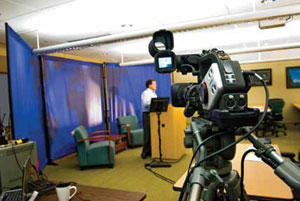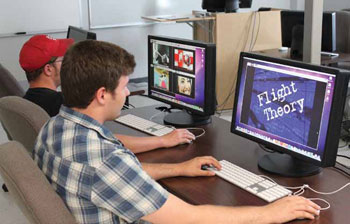Even As Video Streaming Becomes Commonplace Online, Expertise Is Required For Professional Results
Many market segments, including schools such as Liberty University where HaiVision’s Makito Encoder is in use, are looking to replace baseband video with high-performance IP video.
To stream and how to stream, that is the question, and it all depends on an integrator’s familiarity and understanding of network video and how best to deliver it.
Streaming has become a generic term which is commonly defined as the transport of video and/or graphics over an IP-based network, explained John Stark, director, product management and technical services for Jupiter Systems. “The application of streaming has transcended its original use—primarily for video teleconferencing and public security applications where high cost was justified and dedicated networks were created for these specific purposes— to encompass nearly all aspects of corporate and public communication. This trend is played out against the backdrop of ubiquitous access to network bandwidth at a cost per data unit that has dropped precipitously and continues to decline. Coupled with advances in compression algorithms and the computing hardware that encodes and decodes these compressed streams, it is now possible to transmit high-definition video with extremely high quality over public networks utilizing a small fraction of the bandwidth available.”
Collaboration at the user desktop, in the boardroom, in healthcare for remote health management, distance learning, and public safety, are all applications that use video streaming technologies to advantage. In healthcare, linking X-ray or scanning suites with distant clinicians is common and made practical using existing off-the-shelf encoding and decoding capabilities. In transportation, informing the public on road safety and traffic conditions is accomplished through the transcoding and exportation of previously proprietary internal video—so that news outlets can show exact up-tothe- minute traffic video without having to co-locate expensive satellite links from highway departments to affiliate offices.
“Tools like Skype, Messenger, ICQ, GotoMeeting, GotoSeminar, etc. are variants of ‘streaming,’ but in the data and computer workspace,” Stark elaborated. “However, the principal is the same, and the use of public networks (the internet) to carry collaborative data and video together is commonplace. Indeed, the use of these technologies has provided corporate America a real alternative to in-person meeting. Multipart, collaborative meetings can take place with all participants sitting at their computers, regardless of distance or time zone. Even mobile devices such as phones have the ability to encode and stream live video and participate in online data and video meetings.”
With the ability to provide “live” video in place of the playback of canned video content in the digital signage space, streaming will and already has opened up a new source of revenue to insert timely and compelling messaging without having to distribute the entire content to a signage network. This provides a more flexible interface to dynamically change the content in specific geographies based on real-time input.
“Streaming is a fact of life in corporate applications, and the expectation to employ desktop and personal tools in a larger room-based context is the challenge for integrators today,” Stark said. “The price gulf between professional- quality video teleconferencing equipment and ostensibly free tools found on PCs today is narrowing, but it’s large enough to give prospective buyers pause. However, understanding the client’s network and how to integrate streaming solutions into existing infrastructure requires deep understanding of networking technologies and the ability to direct clients and their IT departments to appropriately provision their network for optimal performance. Without this understanding, a system may ‘work,’ but it will yield inconsistent or sub-par visual or data performance.”

Conference Technologies clients often begin their use of streaming technology with its Managed Services Group, and when ready can purchase a solution.
Both Sides Now
The trick to building an integration business with video streaming is to realize that hardware is only a small part of any streaming media solution, noted Jimmy LoMonaco, branch director/national rental director for the Overland Park, KS office of Conference Technologies: “How will content be produced, packaged, and deliver? Success hinges on the answers.”
Conference Technologies offers managed streaming solutions through a rental group as well as pre-event consulting, content creation, video production, web design, and hosting services. About half of its business is in the rental end. “The ability to leverage our integrator expertise in designing and implementing streaming solutions, combined with our experience in facilitating a variety of events, allows us to add market share on both sides of the equation,” LoMonaco said. “Clients can begin their use of streaming technology with our Managed Services Group, which includes traditional rental equipment and production, videoconferencing services, streaming media, facility management, and service departments. When ready, they can purchase a solution from an integrator who already understands their needs.”
In turn, he added, “clients with installed solutions can lean on the expertise of our managed service. Because we offer a complete range of services we can step in at any point in the process to enhance or complement their event.”
Demonstrating the breadth of video streaming’s reach, Conference Technologies has facilitated a variety of events including internal and external training sessions, product launches, church services, concerts, interactive newsletters, and corporate communications. “We have even broadcast a wedding or two to remote family and friends unable to attend either because of distance or inability to travel,” LoMonaco said. “It seems that our world keeps getting smaller and smaller when in actuality, clients, co-workers, and family members are spread across ever increasing geographic areas. Streaming media can be the easy to use, cost effective tool to maintain that that sense of inclusion.”
Making It Real-Time
“The most pervasive applications for streaming are to provide video on internet,” said Peter Maag, EVP for HaiVision Network Video. “Typically, that is of low quality and designed for mass consumption. Through the introduction of high-performance technology, many market segments, such as corporate, education, and healthcare, are looking to replace baseband video with high-performance IP video. The impact of this transition is that you get all the quality and real-time delivery of video signals over IP, so you eliminate distance implications; effectively with IP video you get distribution amps and matrix switches for free. By going over IP you rid yourself of the middle infrastructure typically associated with AV deployments.”
In markets such as healthcare, he said, the number-one stimulation for IP video is to eliminate hubs and coaxial cable. “Once you’re on IP not only do you have the ability to route to as many places as you wish, but also the ability to securely bring highquality video to desktops anywhere and to record that video easily.”
Internet video on-demand content still represents the most usage of streaming, Maag said. “Live streaming has been underutilized because of lack of performance of encoders and the lack of availability of high bandwidth good quality network connections. Now that bandwidth is readily available, applications are expanding dramatically. It used to be that the only video streaming was going through flash streaming servers offering video on demand. Now, with high quality network connections integrators they can offer more creative approaches such as bridging facilities together in high definition in real time at low cost.”
“The main considerations for integrators include understanding networks and controlling the IP video streams,” he said. “Unless you have a strong appreciation for network video and for the software-based systems for controlling it, you won’t get the job done. Integrators need to extend their expertise in control systems to make it easy for their clients to control performance streaming.”
There is also an interesting crossover between video streaming and digital signage application where the main issue has always been content, Maag said. “Many enterprises wanting to launch digital displays will tell you they just want to show CNN, but that’s video streaming. We have had large success with integrators in putting digital signage systems at a headend and implementing streaming solutions to deliver the content to the signs. Systems contractors have been frustrated with signage because it’s content specific. My proposal to them is to take the signage systems, put them at a central spot, and distribute the content via highdefinition video via streaming. It’s great for the contractor and for the client; the contractor doesn’t have to worry about a content system because it’s at a central location and the client doesn’t invest in and commit to a large signage infrastructure. It is simply an open standard H.264 steaming network.”
Getting It Right
“Video streaming is beginning to be embraced as a substantive technology,” said Chris Miller, former chief scientist for Magenta Research. Miller recently launched Technical Product Solutions, a product development company in Brookfield, CT. “It was once thought of as a curiosity and a remarkable accomplishment to those among the network savvy generation, but the development and acceptance of H.264 is paving the way for more serious applications. Improved image quality and the ability to support a respectable frame rate are promoting the technology’s acceptance for more serious applications.
“Having said so, it is not a solution for every project or application,” he said. “Doing streaming delivery well is still expensive, especially where real-time conversion from a native HD format is involved.”
It’s essential for integrators to determine if streaming is the optimum solution by starting with a solid understanding of the overall intent and functionality of any project, Miller said. “If a presentation has to be made in full resolution with no compression artifacts and must be delivered in real time, streaming solutions aren’t the right solution today. Even if the client demands a streaming IP solution, review the issues and give them other options.”
Ocean Stream
Streaming media and content delivery provider StreamGuys teamed with production company AGP Video in September to produce and support live and archived web streams from the California and the World Ocean 2010 Conference. The three-day event featured presentations from respected scientists, professors, and marine biologists as well as government officials from the states of California, Oregon, and Washington; and the Canadian province of British Columbia.
StreamGuys was responsible for receiving, managing, and monitoring all live encoded video and audio streams received from the conference in the Windows Silverlight format. The company also customized a streaming platform and server infrastructure to remotely pull encoded content onto its servers for archival use. In addition to centralizing the operation, StreamGuys minimized costs for AGP Video by supporting “bursts” to handle periods of heavier streaming traffic. The burstable billing model measures bandwidth based on peak utilization, with the freedom to exceed bandwidth commitments for a specified period of time without additional charges.
Margin Builder
“Streaming media solutions are the perfect add-on to any traditional meeting or learning environment,” observed Jimmy LoMonaco of Conference Technologies. “Simply add an encoder to an existing videoconference suite, or add a cameraequipped training room and instantly you create a broadcast studio for live meetings and events, internally or externally. These events can also be recorded and archived for on-demand viewing. The desire to produce higher quality video can necessitate add-ons such as theatrical lighting, video switchers, additional cameras, and microphones.”
